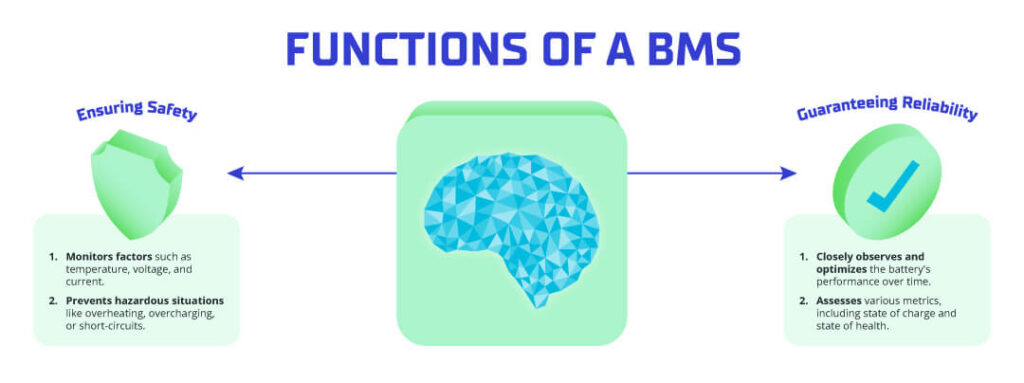
Is a Battery Management System (BMS) essential for meeting modern energy demands?
November 29th, 2023 | Reading Time 4 mins
Battery Management System (BMS) acts as a vigilant protector, guaranteeing the secure, dependable, and effective functioning of batteries in our ever-growing electrified environment
In our contemporary world, batteries have become an integral part of our daily lives, powering essential devices like smartphones and revolutionizing transportation through electric vehicles. As our reliance on these energy storage devices grows, ensuring their safe, reliable, and optimal performance becomes paramount. The answer to this challenge lies in the domain of Battery Management Systems (BMS).
Fundamentally, a Battery Management System (BMS) serves two crucial functions:
Ensuring Safety: Safety is of utmost importance for battery packs, and the BMS plays a critical role by meticulously monitoring factors such as temperature, voltage, and current. This proactive approach prevents potential hazards like overheating, overcharging, and short-circuits, safeguarding both the batteries and the devices they power.
Guaranteeing Reliability: Beyond safety, the BMS focuses on maintaining the consistent and dependable operation of the battery pack. By closely observing and optimizing performance metrics over time, including state of charge and state of health, the BMS ensures reliability, contributing to the longevity and efficiency of the battery.

Balancing The Act?
The BMS excels in cell balancing, a vital process to ensure uniform charge levels among the cells within a battery pack. Despite mass production, lithium-ion cells exhibit charge variations. Large battery packs achieve cell balancing through two primary methods:
Passive Balancing: This method converts excess energy from high State of Charge (SOC) cells into heat, which dissipates. Though cost-effective, it lacks simultaneous cell balancing and can lead to heat management issues, often chosen for automotive applications.
Active Balancing: In contrast, active balancing transfers excess energy from high SOC cells to lower ones until SOC levels align. This process may repeat during subsequent charges. While efficient, it demands costlier hardware and more pack space, involving electronics on each cell or integrated on slave boards for cell groups.
Charvik, an intelligent battery management system, enhances BMS features, aligning with its fundamental functions of prioritizing safety and ensuring the long-term reliability of the battery pack. This contributes to the continuous evolution of energy storage technologies.

A BMS achieves its goals by processing diverse data inputs. It monitors cell and pack voltages, strategically positions temperature sensors for temperature distribution assessment, and meticulously tracks current flow during charging or discharging. Intricate algorithms within the BMS generate crucial outputs. The State of Charge (SOC) acts as a fuel gauge, estimating remaining capacity, while State of Health (SOH) provides insights into long-term capacity. The Safe Operating Envelope determines allowable current, with additional metrics incorporated based on the BMS manufacturer’s specifications. Importantly, the BMS communicates fault signals and status updates to the application controller, ensuring a rapid response to changes or issues concerning the battery’s condition.
Battery Management System(BMS) – The IRL Action
In exploring the practical realm of a Battery Management System (BMS), let’s focus on a 4S, 1P battery pack—four cells connected in series. Picture the BMS as a vigilant guardian, strategically placed near the cells, monitoring various parameters. It scrutinizes individual cell voltages, ensuring they operate within the desired range, while also maintaining the overall pack voltage balance. Acting like an orchestra conductor, it observes current flow meticulously. The BMS features a master disconnect for swift intervention in unsafe states during charging or discharging. Its vigilance extends to external terminals, interfacing with devices like electric vehicle controllers. This external coordination, guided by real-time BMS insights, ensures a harmonious power system.
Quietly shaping the future of our Electrified World
The Battery Management System (BMS) acts as a reliable guardian for your battery pack, ensuring safe and efficient operation. Not only does it protect against potential risks, but it also provides vital data to external systems, enabling real-time performance adjustments. As technology advances, the BMS proves crucial in various applications, playing a silent yet indispensable role in our battery-dependent world. Whether extending the lifespan of electric vehicle batteries or enhancing the reliability of renewable energy storage, the BMS remains an unsung hero, dedicated to powering the future with utmost safety and efficiency.
In our ever-evolving tech landscape, the unassuming BMS quietly oversees energy systems, ensuring the reliable function of battery packs in devices from phones to electric vehicles. Its importance grows as technology advances, contributing to longer battery life, supporting green energy initiatives, and fostering a sustainable future.
The BMS is an unsung hero, toiling in the background to keep our energy storage systems running smoothly. Its knack for safeguarding investments, prolonging battery life, and optimizing performance speaks volumes about its crucial role in our battery-centric world. Looking ahead, you can bet the BMS will continue shaping technology, making sure we tap into energy storage’s full potential while keeping safety and efficiency in the spotlight.






K R MOHAN
2 years agoMonitoring the heat generated by individual cells and keeping them from thermal runaway by point cooling and galvanic isolation and reconnection based on dynamic feedback and metronomic precision control should pave way for safer horizons.